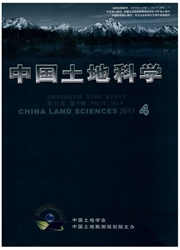

 中文摘要:
中文摘要:
研究目的:从居民的通勤行为特征中寻求小城镇土地利用格局优化路径,为产城融合的实现提供理论支持。研究方法:构建通勤流矩阵,运用Arc GIS路径分析测算通勤距离,并通过缓冲区分析通勤距离在空间上的特征,并与土地利用类型进行对比分析,同时建立通勤距离与社会经济因素的回归方程,分析通勤距离的影响因素。研究结果:小城镇通勤方式以便捷型工具为主,通勤高峰集中于上下班,通勤距离随着城镇化和工业化水平的提高,短距离占比增大。主要结论:在城镇化和工业化发展较快的区域,短距离通勤集聚更具有"同心圆"特征,核心力更强。工业化带动的聚集结构呈现出"条带形"态势,与区域工业布局结构有较密切的关系,也与城镇化和工业化扩增融合有关。短距离通勤集聚区会随着城镇化水平的提高而由"双核"向"单核"结构发展,并针对以上问题提出了相应的对策。
 英文摘要:
英文摘要:
The purpose of the paper is to explore the way to optimize the land use structure of small towns in light of the characteristics of residents’ commute behavior, and to provide theoretical support for the realization of cityindustry integration. The methods employed are building a commuter flow matrix, measuring the commute distance by path analysis of Arc GIS, analyzing the space characteristics of commute distance by buffer analysis and comparing it with the land use type so as to reveal the factors affecting commute distance by establishing linear regression equation between commute distance and the socio-economic factors. The research results indicate that in the regions with rapid urbanization and industrialization, the short-distance commuter agglomeration exhibits a feature of "concentric circle", of which the core force is stronger. The agglomeration structure driven by industrialization has a "strip-shaped" trend, which is closely related to regional industrial distribution structure as well as the expansion and integration of urbanization and industrialization. The short-distance commuter agglomeration area will change from the "dual-core" to "single-core" structure along with the improvement of urbanization level. In conclusion, we put forward corresponding countermeasures and suggestions according to the issues above.
 同期刊论文项目
同期刊论文项目
 同项目期刊论文
同项目期刊论文
 期刊信息
期刊信息
